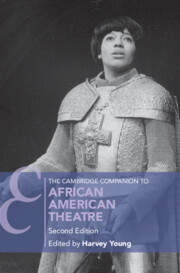Refine search
Actions for selected content:
19 results
Chapter 13 - Race
- from Part II - Themes and Issues
-
-
- Book:
- The Cambridge Companion to Modernist Theatre
- Published online:
- 28 August 2025
- Print publication:
- 11 September 2025, pp 233-249
-
- Chapter
- Export citation
Chapter 2 - Betweenness
-
- Book:
- Embodiment in Nineteenth-Century American Literature
- Published online:
- 29 June 2025
- Print publication:
- 17 July 2025, pp 55-82
-
- Chapter
- Export citation
6 - American Popular Visual Culture and Ireland, 1840s–1920s
-
-
- Book:
- America in Ireland
- Published online:
- 09 January 2025
- Print publication:
- 23 January 2025, pp 144-175
-
- Chapter
- Export citation
Chapter 3 - Race, Minstrelsy, and the Irish Stage
-
-
- Book:
- Race in Irish Literature and Culture
- Published online:
- 04 January 2024
- Print publication:
- 18 January 2024, pp 59-80
-
- Chapter
- Export citation
Chapter 5 - Blackface Minstrelsy, Irish Modernism, and the Histories of Irish Whiteness
-
-
- Book:
- Race in Irish Literature and Culture
- Published online:
- 04 January 2024
- Print publication:
- 18 January 2024, pp 103-120
-
- Chapter
- Export citation
Coppélia's Human-Objects: Winding Up Racialized Automata on the Ballet Stage
-
- Journal:
- Dance Research Journal / Volume 55 / Issue 3 / December 2023
- Published online by Cambridge University Press:
- 08 May 2024, pp. 30-46
- Print publication:
- December 2023
-
- Article
-
- You have access
- Open access
- HTML
- Export citation
4 - Attacks on the Identities of Groups
- from Part I - The Ordinary Concept
-
- Book:
- Hate Speech Frontiers
- Published online:
- 26 October 2023
- Print publication:
- 09 November 2023, pp 209-326
-
- Chapter
- Export citation

The Cambridge Companion to African American Theatre
-
- Published online:
- 08 June 2023
- Print publication:
- 22 June 2023
Chapter 8 - Slavery and the Virtual Archive: On Iran’s Dāsh Ākul
- from Part III - Legacies and Afterlives
-
-
- Book:
- The Cambridge Companion to Global Literature and Slavery
- Published online:
- 15 December 2022
- Print publication:
- 22 December 2022, pp 135-149
-
- Chapter
- Export citation
5 - Blackface Empire: or, the Slavery Meridian
- from Part II - Theaters of Empire
-
- Book:
- Strolling Players of Empire
- Published online:
- 11 November 2022
- Print publication:
- 01 December 2022, pp 251-312
-
- Chapter
- Export citation
4 - Travesty and Transformation
-
- Book:
- Staging Haiti in Nineteenth-Century America
- Published online:
- 18 November 2022
- Print publication:
- 01 December 2022, pp 120-149
-
- Chapter
- Export citation
Chapter 2 - Joyce and Race in the Twenty-First Century
- from Part I - Scope
-
-
- Book:
- The New Joyce Studies
- Published online:
- 01 September 2022
- Print publication:
- 08 September 2022, pp 35-49
-
- Chapter
- Export citation
Chapter 3 - The Black-White Gentleman
-
- Book:
- Shakespeare and British World War Two Film
- Published online:
- 24 March 2022
- Print publication:
- 31 March 2022, pp 96-135
-
- Chapter
- Export citation
11 - Italian Impresarios, American Minstrels and Parsi Theatre
-
-
- Book:
- Italian Opera in Global and Transnational Perspective
- Published online:
- 17 March 2022
- Print publication:
- 24 March 2022, pp 214-238
-
- Chapter
- Export citation
Chapter 2 - The Materials of Race
-
-
- Book:
- The Cambridge Companion to Shakespeare and Race
- Published online:
- 09 February 2021
- Print publication:
- 25 February 2021, pp 17-29
-
- Chapter
- Export citation
Chapter 16 - Are Shakespeare’s Plays Racially Progressive?
-
-
- Book:
- The Cambridge Companion to Shakespeare and Race
- Published online:
- 09 February 2021
- Print publication:
- 25 February 2021, pp 237-253
-
- Chapter
- Export citation
Chapter 12 - Island Relations, Continental Visions, and Graphic Networks
- from Part III - Re-mapping the New Negro
-
-
- Book:
- A History of the Harlem Renaissance
- Published online:
- 20 January 2021
- Print publication:
- 04 February 2021, pp 211-232
-
- Chapter
- Export citation
Ballets Russes and Blackface
-
- Journal:
- Dance Research Journal / Volume 52 / Issue 3 / December 2020
- Published online by Cambridge University Press:
- 29 December 2020, pp. 76-96
- Print publication:
- December 2020
-
- Article
- Export citation
Blackface Abolition and the New Slave Narrative
-
- Journal:
- Cambridge Journal of Postcolonial Literary Inquiry / Volume 2 / Issue 1 / March 2015
- Published online by Cambridge University Press:
- 16 December 2014, pp. 93-113
-
- Article
- Export citation
